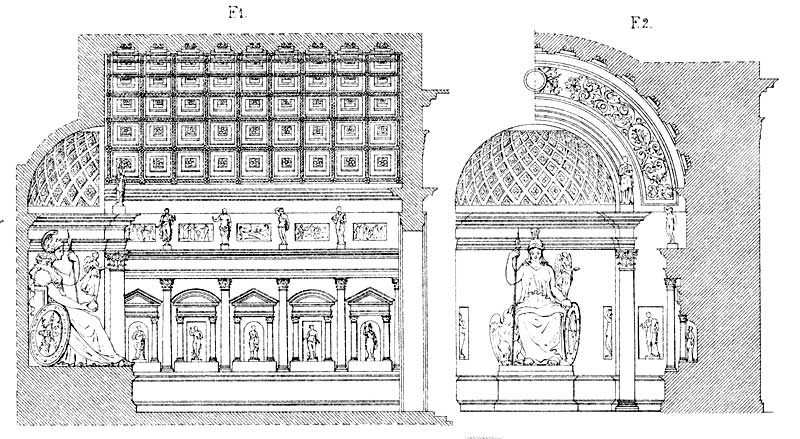- Temple of Venus and Roma
Ancient monuments in Rome
name=Temple of Venus and Roma
label_name=Temple of Venus and Roma
tekst1=
label_x=0.38
label_y=0.37
location=Regione VIII "Forum Romanum"
date=135 AD
builder=Hadrian
type=Roman temple |The Temple of Venus and Roma (Latin: "Templum Veneris et Romae") was the largest known temple in
Ancient Rome . Located at the far east side of theForum Romanum near theColosseum , it was dedicated to the goddesses Venus Felix (Venus the Bringer of Good Fortune) andRoma Aeterna (Eternal Rome). The architect was the emperorHadrian . Construction of the temple began in121 . It was officially inaugurated by Hadrian in135 , and finished in141 underAntoninus Pius . Damaged by fire in307 , it was restored with alterations by the emperorMaxentius .History
In order to build the temple, erected on the remains of
Nero 'sDomus Aurea , theColossus of Nero was moved and placed near theamphitheatre , which shortly afterwards became known as theColosseum . Unimpressed by his emperor's architectural skills,Hadrian 's most brilliant architect, Apollodorus, made a scornful remark on the size of the seated statues within the cellae, saying that they would surely hurt their heads if they tried to stand up from their thrones. Apollodorus was banished and executed not long after this.Further restoration was performed under
Eugenius , a short-lived usurper (392-394) againstTheodosius I , whose policy was the restoration of Pagan cults and temples.A severe earthquake at the beginning of the
9th century unfortunately destroyed the temple once again. Around 850Pope Leo IV ordered the building of a new church, Santa Maria Nova, on the ruins of the temple. After a major rebuilding in1612 , this church was renamed Santa Francesca Romana, incorporating Roma's cella as thebelltower .Over the centuries most of the columns surrounding the temple disappeared. Presently only a few remain standing in their original positions, while others that have gone missing have been replaced by
buxus trees.Architecture
Set on a "
stylobate " measuring convert|145|m|ft|0 in length and convert|100|m|ft|0 in width, and stood convert|29.5|m|ft|0 tall, being convert|31|m|ft|0 counting the statues, the "peristyle " (also "peripteral") building measured convert|110|m|ft|0 in length and convert|53|m|ft|0 in width. The temple itself consisted of two main chambers ("cella e"), each housing a cult statue of a god—Venus, the goddess of love, and Roma, the goddess ofRome , both figures seated on a throne. The cellae were arranged symmetrically back-to-back. Roma's cella faced west, looking out over the Forum Romanum, and Venus' cella faced east, looking out over the Colosseum. A row of fourcolumn s ("tetrastyle ") lined the entrance to each cella, and the temple was bordered bycolonnade d entrances ending in staircases that led down to the Colosseum.The west and east sides of the temple (the short sides) had ten white columns ("
decastyle "), and the south and north (the long sides) featured eighteen white columns. All of these columns measured convert|1.8|m|ft|0 in width, making the temple very imposing.A reconstruction of the temple interior by German Architect Josef Bühlmann from 1913 depicts two longitudinal colonnades of Corinthian columns forming a central
nave flanked by twoaisle s below acoffer ed vaulted ceiling. Resting on the columns a double impost forms a doubleentablature extending back into theexedra , with a cofferred half-dome ceiling above the seated statue. The walls behind the aisles are inset with smaller columns standing some distance above the floor on a plinth. Small statues set in niches between these columns punctuate the walls, the niches surmounted by alternatingarch ed and triangularpediment s. More small statues are positioned on theentablature above each small column.As an additional clever subtlety by Hadrian, Venus also represented love ("Amor" in Latin), and "AMOR" is "ROMA" spelled backwards. Thus, placing the two divinities of Venus and Rome back-to-back in a single temple created a further symmetry with the back-to-back symmetry of their names as well. Within Venus' cella was another altar where newly wed couples could make sacrifices. Directly adjacent to this altar stood gigantic silver statues of
Marcus Aurelius andFaustina the Younger .References
External links
Bibliography
* Sandro Lorenzatti, "Vicende del tempio di Venere e Roma nel Medioevo e nel Rinascimento", in "Rivista dell’Istituto Nazionale di Archeologia e storia dell’Arte", 13, 1990, pp. 119-138.
Wikimedia Foundation. 2010.
